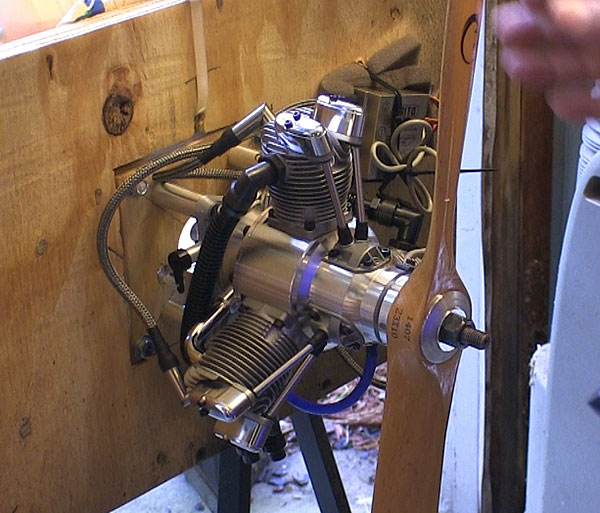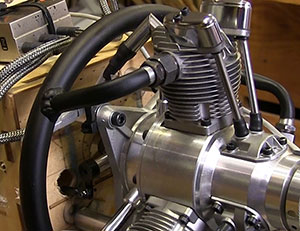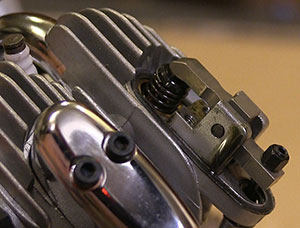



Having a radial engine on a RC plane was one of my bucket list goals. It was a good
one also.
Text, photos and video by Tom Hintz
Flight video by – Clark Ponthier
Posted – 6-3-2016
From the first time I heard a radial RC engine I knew one was in my future. These days, “in my future” has more of a hurry up factor than before so it should surprise few that with the help of some friends I suddenly own a Saito 60cc Radial. After opening the box it came in there would be a few surprises for me, all happy ones.
The Saito Radial (#FG-60R3) is a 3-cylinder engine with a displacement of 3.68 cu. in. or 60.32cc. One of the biggest surprises was that the all up weight of 4.6 lbs (2.09 kg) makes replacing a 60 or 70cc single or twin cylinder engine less of a Center of Gravity issue than we might expect. Saito says the Saito 60cc Radial develops about 4.6hp which was not hard to believe after the first time I momentarily took it to full power on the test stand that began moving as a result of the thrust.
The Saito 60cc Radial has the nearly universal 10mm prop shaft and can swing 2 blade props in the 22 X 10 to 23 X 10 range and maintain the approximate 6700 rpm range that Saito indicates is the sweet spot. There are no prop bolts like on most gas RC engines but rather a serrated washer system with a main nut and a second locking nut that also has the bolt hole in its center for securing a spinner.
The electronic ignition that comes with the Saito 60cc Radial is 2S, 7.4V Li-Po compatible which will certainly make starting easier whether you use an electric starter or hand flip it. The Saito SP2 spark plugs are much smaller than the CM6 NGK plugs most other engines use but they do look more “scale” on the engine. I do hope that these spark plugs last a long time because early (and quick) searches show prices of around $18.95 per plug!
The Saito 60cc Radial comes with three exhaust pipes with each length sized specifically for one of the three cylinders. These pipes and the 90-degree fittings that connect them to the cylinder ports are easy to install and are in fact effective. The level of sound from the Saito 60cc Radial is surprisingly low and with the stock exhaust it does have a bit of the bumpety-bump exhaust sound that makes radials sound so cool.
There is a specially designed ring-style exhaust collector made by Keleo Creations that enhance’ s this radial sound with a lower tone that at speed makes the Saito 60cc Radial sort of growl across the sky. My initial attraction to the radial engine was the sound so after the initial runs my Saito 60cc Radial now sports the Keleo ring.
The Keleo ring comes with a smoke nipple that screws into a pre drilled and tapped hole at the top of the ring. For those of us that won’t be using a smoke system Keleo also provides a brass screw with which to seal that hole. The Keleo comes with a longer than necessary oval shaped exit tube that you can trim if necessary to best fit your plane.
The standard exhaust sounds good but
the Keleo header sounds way better.
The Saito 60cc Radial comes with standoffs and bolts for mounting. This setup gives you a 167.5mm firewall to prop washer distance that fits many planes almost perfectly. I had to put two normal thickness washers under the standoffs to get the prop clear of the YAK cowl that was installed around an EME 70cc Twin. The Saito 60cc Radial has an overall outside dimension of 220mm which means it fits within many round cowls on 50cc and larger planes without extensive modifications (if any) to the cowl.
Not everything is sunshine and happiness with the Saito 60cc Radial. Included with this very nice motor is what they erroneously call an instruction manual/pamphlet. We need to find out who is selling the folks in the Pacific Rim something purported to be a translating program that is so poorly done that what comes out of it looks more like someone’s practical joke than something even basically instructive. Perhaps Saito is on the brink of financial disaster and the penny or two per unit it would cost to have someone who actually knows the English language correct their manual to where it at least appears that they care if their customers use their product correctly.
The saving grace (loosely put) is that the translation program is consistent in its stupidity. As you scan the pages for something that resembles a sentence you begin to notice that in places two or three errors occasionally add up to a hint about what they meant. There are also single sentence’s scattered through the pages where it looks like the program had a moment of clarity but you realize that it is really legalese injected by some corporate council. Then the translation program takes over again and upchucks more groups of words that seem to have little to do with each other.
Saito gets a big fat F for the “we don’t care” instruction manual.
The instructions give starting points for both needle valves so I set those and fired the Saito 60cc Radial with my electric starter. After letting it warm up it would get to nearly 5000rpm at full throttle so I opened the main needle another full turn and the rpm dropped to about 3800rpm, very close to the 4000 rpm the instructions call for. This is to keep a huge amount of the 20 to 1 gas/oil mixture throughout the engine during the crucial period when lots of internal parts are essentially lapping themselves to each other. The instructions call for two tanks of fuel for the initial pre flying break in period but I ran five full tanks on the ground to be very sure I was not rushing it. Many manufacturers recommend extending the break in period when using synthetic oils like the Redline I use because it lubricates so much better than petroleum-based oils that it delays parts wearing into each other. To be honest, some of those tanks of fuel I ran through the Saito 60cc Radial were because it’s not tough listening to this engine even when it is not flying.
For the early break in flights I used a 23B Vess (roughly an 8 pitch) and made sure to vary the throttle frequently. One of the things I like to do during break in is a bunch of touch and goes. That forces the use of near full power for short periods during the take off and then lower throttle settings during the approach and landings. Between these break in friendly flights and keeping the engine running a bit rich the Saito 60cc Radial seemed to be coming in nicely. The compression was noticeably better than when it came out of the box and the rpm at all throttle settings was becoming far more consistent. I continued these break in flights with the rich settings through the first two gallons of 20X1 (actually closer to 18 to one, went a bit heavy on the Redline Synthetic Racing Oil) fuel oil mix.
Several people told me they did not want
to deal with "constant" adjusting of the
valve train. I flew my radial a bunch and
never had that issue.
During the first two tanks of fuel the Saito 60cc Radial became ridiculously easy to start. At the field some of the guys were gawking at my radial when I gave it a half-hearted partial flip and it started. While writing this review I took the YAK and the Saito 60cc Radial out of the trailer where it had been sitting for several days to see how easily it started totally cold. I flipped the prop three times with the ignition off to get some fuel into the cylinders, turned the ignition on and one flip and it was happily bumpety-bumping along in my starting restraint. I had not expected that kind of easy starting and really don’t know what it is about this motor that makes it so easy to fire up. One starting issue I am still fighting is how to install the prop to make getting a decent flip through compression. I really did look in the instruction manual but don’t have a clue if it is trying to say anything about prop alignment for starting.
Being a four stroke motor we have a valve train that needs occasional attention. The tools needed for setting the valve clearance are included. Setting the “tappets” is a simple procedure and one you need to perform now and then more as a check for wear than anything. Finding a need for small changes is normal, especially during and just after the break in period. If you check and find one tappet that needs a substantial adjustment you need to figure out if the adjuster was left loose or if something is wearing abnormally. My Saito 60cc Radial came with the tappets nicely adjusted and I needed to tweak two valves just a little bit after the first few gallons of gas.
Something that surprised me about this review is the number of people who are surprised (a few leaning towards angry) that I am putting a radial engine in an aerobatic plane and not a warbird. I realize that a multi-cylinder engine lacks some of the brute power a single cylinder engine of the same displacement produces. All of my aerobatic planes are over powered to start with so the Saito 60cc Radial might be closer to the actual needed power. We will see.
The first couple of weeks were devoted to lots of partial throttle flying and touch and goes. I kept the Saito 60cc Radial a bit rich all of the time to be sure temperatures and lubrication remained good for wearing the moving parts in slowly.
I had run about three gallons of 20:1 gas/Redline Synthetic oil through the Saito 60cc Radial when I started the process of leaning it out a tiny bit at a time on the way to full speed operation. I like staying on the rich side of carburetor settings to protect my engine investments. Currently the RPM still hovers around 6000 RPM and the throttle response is getting better and better. I also am flying the Saito 60cc Radial in my RedwingRC 50cc YAK 55 with a Xoar 22X10 prop which this combination seems to like.
Even at these reduced power levels it is obvious that the Saito 60cc Radial has what it takes to fly my 16lb RedwingRC 50cc YAK 55. I had started with a 23X8 prop and the YAK felt just a touch lazy, again the Saito 60cc Radial was running rich. But when I put on the Xoar 22X10 the Saito 60cc Radial and the YAK came to life, the occasional rich sputter and all. I am going to fly the Saito 60cc Radial in this configuration for another gallon of fuel and then slowly begin leaning it out to where it is happy on both the top and bottom ends. Stay tuned for a separate story once I get this combination broken in and tuned.
The Saito 60cc Radial is a great motor with the radial sound I was looking for. It has more power than I expected from a three-cylinder engine and it is certainly far smoother than anything I have bolted on a plane. One of the biggest surprises was how easy it was to go from a EME 70cc Twin to the Saito 60cc Radial in terms of weight and balance. It was also a welcome surprise when the radial fit inside the YAK cowl without a bunch of cutting.
At $1099.00 (6-3-2016) the Saito 60cc Radial is not a bargain priced motor but for what you get I think the price is not bad at all. Though it comes with a good exhaust system I just could not stop myself from adding the Keleo ring exhaust collector ($189.99, 6-3-2016) that deepens the radial sound as well as making it sound great in the air. That was an easy change to make mechanically and once again did not impact the fit in the cowl.
Would I get another radial engine? Absolutely. I am impressed with the quality of the Saito engineering and manufacturing and would not hesitate to get another of their engines or one of the Moki’s that seem to dominate the radial world.
Visit the Saito 60cc Radial web page – Click Here
Have a comment on this Review? –Email Me!